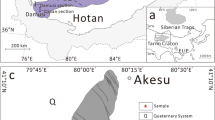Abstract
Volcanic rocks in seamounts of the South China Sea consist mainly of alkali basalt, tholeiitic basalt, trachyandesitic pumice, dacite, etc. Inclusions in the minerals of the volcanic rocks are mainly amorphous melt inclusions, which reflects that the volcanic rocks are characterized by submarine eruption and rapid cooling on the seafloor. Furthermore, fluid-melt inclusions have been discovered for the first time in alkali basalts and mantle-derived xenoliths. indicating a process of differentiation between magma and fluid in the course of mantle partial melting. Alkali basalts and inclusions may have been formed in this nonhomogeneous system.
Rock-forming temperatures of four seamounts were estimated as follows: the Zhongnan seamount alkali basalt 1155 ∼ 1185 °C; the Xianbei seamount alkali basalt 960 ∼ 1200 °C; tholeiitic basalt 1040 ∼ 1230 °C; the Daimao seamount tholeiitic basalt 1245 ∼ 1280 °C; and the Jianfeng seamount trachyandestic pumice 880 ∼ 1140 °C. Equilibrium pressures of alkali basalts in the Zhongnan and Xianbei seamounts are 13.57 and 8.8 × 108 Pa, respectively. Pyroxene equilibrium temperatures of mantle xenoliths from the Xianbei seamount were estimated at 1073 ∼ 1121 °C, and pressures at (15.58 ∼ 22.47)×108Pa, suggesting a deep-source (e.g. the asthenosphere) for the alkali basalts.
Similar content being viewed by others
References
Department of Geotectonics, Institute of South China Sea Oceanology, Academia Sinica. 1988, Geotectonics of the South China Sea and the expansion of continental margin: Beijing, Science Press, p. 150–158 (in Chinese).
Green, D.H. and A.E. Ringwood. 1967, The genesis of basaltic magmas: Contr. Mineral and Petrol., v. 15, p. 103–109.
Li Zhaolin, ed., 1988, Experimental Geochemistry: Beging, Geology Press, p. 227–322 (in Chinese).
Liu Yingjun et al., 1985, Inclusions in minerals from the selected basalts in eastern China: Geochimica, n.3, p. 216–226 (in Chinese with English abstract).
Lu Huanzhang. 1990, Fluid-melt inclusions: Geochimica, n.3, p. 225–229 (in Chinese with English abstract).
Melan, E. and Zhao Dasheng, eds., 1987, Cenozoic basalts and their xenoliths in eastern China: Beijing, Science Press, p. 349–476 (in Chinese).
Mercier, J.C.C., 1976, Single pyroxene geothermometry and geobarometry: Am. Mineral., v. 60, p. 603–615.
Roedder, E., 1984, Fluid inclusions: Mineralogical Society of America, p. 473–503 (Chinese version).
Wang Xianjue et al., 1984. Geochemical characteristics of the basalts in the South China Sea: Geochimica, n.4. p. 332–339 (in Chinese with English abstract).
Xia Linqi, 1981, Olivine geothermometry: Journal of the Chinese Academy of Geological Sciences, v. 2, p. 73–81 (in Chinese).
Yoder, H. S. Jr, 1982, Petrogenesis of basalt magma (Chinese version): Beijing, Geology Press, p. 109–168 (in Chinese).
Zhou Xinmin, Chen Tuhua. 1981, Petrochemistry and evolution of the Cenozok basalts in the southeast coastal area of China: Acta Geologica Sinica, n.l, p. 29–39 (in Chinese with English abstract).
Author information
Authors and Affiliations
Additional information
This project was financially supported by the National Natural Science Foundation of China and Guangzhou Marine Geology Survey.
Rights and permissions
About this article
Cite this article
Zhaolin, L., Zhili, Q., Shecai, Q. et al. A study on the forming conditions of basalts in seamounts of the South China Sea. Chin. J. of Geochem. 13, 107–117 (1994). https://doi.org/10.1007/BF02838511
Issue Date:
DOI: https://doi.org/10.1007/BF02838511




